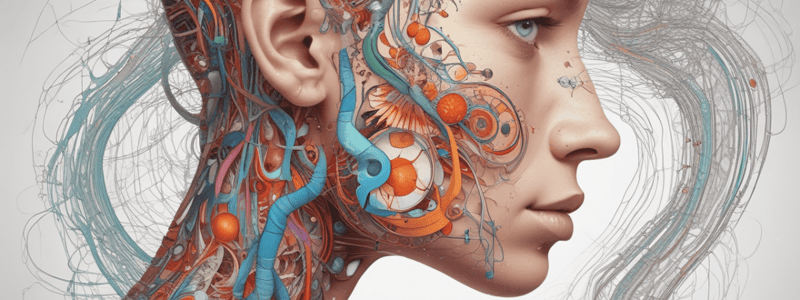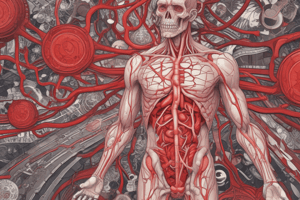Podcast
Questions and Answers
What is the primary function of sweat evaporation on the skin?
What is the primary function of sweat evaporation on the skin?
- To regulate body hydration
- To regulate body temperature (correct)
- To regulate blood pressure
- To regulate muscle activity
What triggers the same neural response that activates thermoreceptors when eating spicy food?
What triggers the same neural response that activates thermoreceptors when eating spicy food?
- The stimulation of muscle activity
- The activation of sweat glands
- The increase in body temperature (correct)
- The release of adrenaline
What is another situation that triggers the fight-or-flight response, leading to sweating?
What is another situation that triggers the fight-or-flight response, leading to sweating?
- Public speaking (correct)
- Taking a cold shower
- Eating a large meal
- Watching a scary movie
What happens to the sweat response when we recover from an illness?
What happens to the sweat response when we recover from an illness?
What is another function of the hypothalamus in relation to sweating?
What is another function of the hypothalamus in relation to sweating?
What is the role of the hypothalamus in sweating when we are sick?
What is the role of the hypothalamus in sweating when we are sick?
What is the primary reason for the increase in sweat production during exercise?
What is the primary reason for the increase in sweat production during exercise?
Where does the process of energy production take place during exercise?
Where does the process of energy production take place during exercise?
What is the purpose of the surrounding cells absorbing salt during sweat production?
What is the purpose of the surrounding cells absorbing salt during sweat production?
What is the function of thermoreceptors in the body?
What is the function of thermoreceptors in the body?
What is the composition of the fluid released by sweat glands?
What is the composition of the fluid released by sweat glands?
What is the location of most sweat glands in the body?
What is the location of most sweat glands in the body?
Study Notes
• When exercising, the body's speed increases, breathing becomes deeper, heart rate accelerates, and sweat appears on the skin.
• Sweat is triggered by several factors, including eating spicy food, nervousness, and illness, but exercise is the most common cause.
• During exercise, muscles increase their activity, requiring more energy, which is produced by cellular respiration that consumes glucose and oxygen to form ATP molecules.
• This process takes place in mitochondria, and as the body moves more, the mitochondria increase their activity to provide energy to the body.
• However, this energy production has a cost, as it generates heat, which is detected by thermoreceptors in the body.
• The thermoreceptors send signals to the hypothalamus, which regulates body temperature, and in response, it sends signals to the sweat glands in the skin.
• The sweat glands, located throughout the body, especially in the palms of the hands, soles of the feet, and head, receive these signals and release a fluid containing high concentrations of sodium and chloride.
• The cells then pump these ions into a hollow tube that passes through the sweat gland, and due to the concentration difference, water flows into the tube through osmosis.
• As the sweat secretion increases, the water pressure pushes the sweat up through the tube, and before it reaches the skin, surrounding cells absorb as much salt as possible to maintain the process.
• The sweat evaporates on the skin, cooling the body, which is a crucial mechanism for temperature regulation.
• This process, known as evaporative cooling, was essential for our ancestors and still benefits us today, not only during exercise but also in other situations.
• Eating spicy food can cause some people to sweat profusely, as it triggers the same neural response that activates thermoreceptors, which respond to temperature increases.
• Sweating is also part of the fight-or-flight response, which is triggered in stressful situations, such as public speaking or job interviews, as adrenaline stimulates muscle activity and increases blood vessel diameter, leading to increased heat and sweating.
• When we are sick, sweating can occur as the hypothalamus increases muscle activity to generate heat and fight off pathogens.
• After exercising or recovering from an illness, the hypothalamus senses the decrease in body temperature and stops the sweat response.
• In some cases, the hypothalamus may also send signals to the body to replenish lost water, leading to feelings of thirst.
Studying That Suits You
Use AI to generate personalized quizzes and flashcards to suit your learning preferences.
Description
Learn how the body regulates its temperature through sweating, and how exercise, spicy food, nervousness, and illness can trigger sweat responses. Discover the role of thermoreceptors, hypothalamus, and sweat glands in this crucial process.





